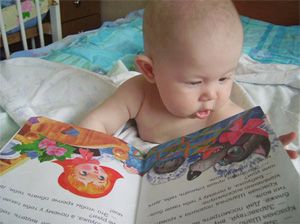Early infancy is left behind. Now the baby will not be bothered by colic, and if earlier the crumbs had problems sleeping due to soreness in the tummy, this most likely will not happen. Formed earlier mode 2-3 month will be adjusted. The reason for this is a decrease in the number of feedings during the day and an increase in the duration of wakefulness.
Features of the day 4 month old baby
The main difference between the period is a decrease in the duration of the daily rest. In total, the baby has been sleeping for 16 hours, which, of course, affects the daily routine of the child at 4 months. He sleeps the longest at night - he can rest up to 10 hours without a break. And in the afternoon it is already possible to take a nap 3 times, the duration of rest is about 2 hours. In the future, three daily naps will continue. Only the duration of each period will change.
The daily routine of a newborn at 4 months is also affected by a reduction in the number of feedings. Instead of the usual 6 times, 5 times becomes enough. Such a daily routine of the child is formed faster at 4 months for artificial feeding. Now mom prepares more formula for him (180-200 g), the baby eats well and stays full longer. Already at this age, artificers are recommended to introduce complementary foods, although this moment very individual. And if there are no direct indications or recommendations of the pediatrician, you should not rush.
The daily routine of a child at 4 months with breastfeeding changes in the same way: the baby has grown up, eats more milk, there is no need for complementary foods yet, since mother's milk has sufficient nutritional value.
You can roughly characterize the daily routine of a child at 4 months in the table.
| 6.00 | Awakening and first feeding |
| 6.30-8.00 | wakefulness |
| 8.00-10.00 | "Quiet Hour" |
| 10.00 | Awakening and second feeding |
| 10.30-12.00 | wakefulness |
| 12.00-14.00 | daytime sleep |
| 14.00 | Third feeding |
| 14.30-16.00 | Baby doesn't sleep |
| 16.00-18.00 | third day dream |
| 18.00 | Awakening and fourth feeding |
| 18.30-21.00 | Evening wakefulness |
| 21.00-22.30 | First part of a night's sleep |
| 22.30 | Night feeding |
| 23.00-6.00 | Complete night's rest |
If the baby does not sleep at night
Some babies delight their parents with a peaceful night's sleep until the morning. Others wake up at night and do not let anyone sleep. Is it possible to change the daily routine of a newborn at 4 months so that his nightly sleep is long and calm? It is possible, and for this it is necessary to remove the first part of the night's sleep, replacing it with a period of wakefulness.
To some, this may seem “cruel”: if the baby is whining and naughty, not putting him to bed means committing a “crime”. However, look at it from the other side: a baby who woke up at 18.00, played enough with his parents, bathed well and ate heartily at 23.00, will not just fall asleep when he is put to bed. He will instantly “turn off” and wake up no earlier than 6 in the morning. At the same time, everyone will rest, and mom and dad will even have time to communicate with each other. Is it worth an hour of child's whims? You decide.

Games, exercises, walks, bathing
- During the wakefulness period, which now lasts longer, you can do a lot. For example, play with the baby in educational games that include activities for the development fine motor skills, have fun with him, playing his favorite children's game "coo-coo". Games can be combined with more active gymnastics. Physical exercises can be performed on a fitball, it is useful to put the baby on its legs, resting the feet on a rough surface. Do not forget about massage: stroking the back and chest, arms and legs, hands and feet are incredibly useful up to 1 year.
- Charging plan for the period of the second wakefulness. Before this, the baby should be washed, combed. So you form in your baby the awareness of the beginning of a new day. After washing and gymnastics, the baby will be cheerful and active, completely ready for new games and discoveries.
- Do not forget to include at least 2 walks in the child's regime at 4 months. Plan the first in the morning, the second - in the late afternoon. While walking in a stroller, babies fall asleep well, especially if they ate before that. A baby can sleep on the street for up to 3 hours: do not disturb him. Walk around the park, enjoying the silence and fresh air. The second walk may already be with dad, who has returned from work. In the meantime, you'll have time to cook dinner. Take a walk, regardless of the weather and time of year - being outside is very beneficial for the little ones.
- Toward evening, the baby should be bathed. Most often it becomes a kind of ritual preparation for sleep. Very soon, your baby will get used to this routine and will calmly go to bed, taking a bath and having a good meal, until the morning.
By forming such a sleep pattern for a child at 4 months old, you create healthy conditions for his growth and development and ensure the normal rhythm of your family's life.
In this article:
The fact that babies grow quickly, every mother can be convinced from her own experience. 4 month old baby becomes noticeably more inquisitive and active. The time of his wakefulness gradually increases, and the periods of sleep and rest become shorter. Children begin to reach for toys and are more willing to make contact with their parents.
The daily routine of a child at 4 months consists of sleep, feeding, hygiene procedures, walks and games. You also need to devote time to gymnastics and massage, which prepare him for independent crawling and sitting.
Baby routine at 4 months
The mood and well-being of the baby largely depends on how his day is planned. If feeding, sleeping and waking are subject to a certain routine, the child will be safe and comfortable. So, what should be the daily routine 4- month old baby- Let's take a closer look.
Nutrition
How much should a baby weigh at 4 months? Body weight and height in a healthy infant correspond to each other. The table shows what the normal height and weight of a child should be at 4 months.
If the weight of a child at 4 months is included in the criteria of the norm, he receives a sufficient amount of nutrition and does not need. Otherwise, the specialist will help to find out the cause of underweight and choose a mixture that meets all the needs of the child.
If 4 months old breast baby is artificially fed, he still receives an adapted mixture, but at the same time he is introduced into his diet. As a first course, after the milk mixture, the child is offered fruit juice or puree, starting with a teaspoon, the volume is gradually adjusted to 150 ml. It is administered in the morning 30 minutes before the mixture. Since such food is absorbed longer by the digestive tract 4 month old baby, Unlike breast milk, the number of feedings is reduced to 5 times.

Complementary foods are also introduced to infants who are on. Regardless of what kind of food the baby receives - breast or mixture, he needs 1000 ml of milk per day, or 1/7 of his body weight.
Dream
For a child at 4 months, the daily routine is adjusted by reducing the daily rest - the need for sleep remains, but now instead of 20 it is enough for him to sleep 15-16 hours a day.
Given that children are individuals, babies can behave differently. Some will sleep through the night, while others require a bottle or mother's breast every 3 hours. Some babies need only a little sleep during the day, but they will fall asleep early in the evening, while others will require long motion sickness and attention. All this is quite natural, since each 4 month old baby individual.
Three times a day's sleep of a child lasting from 1.5 to 2 hours is considered normal. At night, children should sleep from 10 to 12 hours. Some babies have fourth month sleep regression occurs. This process is associated with the beginning of a new stage of development nervous system and increased physical activity. The kid is more interested in the surrounding space, moves and masters the turns of the body, in connection with which his rest structure changes.
From now on, he, like an adult, begins to alternate phases of superficial and deep sleep, against this background, babies can lose their appetite for a while, become more excitable and sleep less.
walks
The frequency and duration of walks for a baby at 4 months old does not change - he still needs to be in the fresh air 2 times a day for 1.5-2 hours. Of course, if the weather conditions are right. In severe frost, heat or a windy day, it is better to stay at home.
Any walk, if the baby is not sleeping, should be educational in nature. By four months, children are actively interested in what is happening around, so you need to tell them about the birds and animals walking in the park, plants seen along the way, transport, etc.
Educational games
Since the baby at 4 months continues to be awake for about 8 hours, this period of time should be filled with educational games. You can spend them during the day, when the baby feels good.
For example, the simplest and most exciting entertainment will be walking around the house with the study of various subjects. You can bring the baby to the mirror and tell him about the parts of the body. Swinging on the hands, playing with fingers, "patties" - all this will be interesting for the child.
Nowadays, a lot of educational games are sold in specialized stores, but now almost any item can play this role for a baby. By four months, the baby has only mastered the strong and conscious grip of toys with his hands, and now you can learn to shift them from one palm to another.

Physical development
The regimen for a 4-month-old baby should include morning exercises, as well as 5-minute exercises performed in the afternoon and evening. Strengthening and development of muscles is necessary for the baby, since from this age he begins to move more actively.
From the age of four months, most babies confidently roll over from their back to their stomach. So that this action does not cause difficulties for the crumbs, you need to strengthen their back muscles and abs, for example, using the “bun” game. The child is gently rolled from the stomach to the back and vice versa on a large hard surface, accompanying the gymnastics with phrases about the main character of the fairy tale, who ran away from his pursuers. will also useful exercise"bike".
To strengthen the muscles of the arms and spine, the mother can pull the baby towards herself from a prone position with the help of her hands. This exercise prepares the child for the ability to sit up independently.
When laying the baby on a hard surface - the floor or a changing table, you can rest your hands on his heels, as a result of which he will push off with his legs and make attempts to crawl. This exercise strengthens all muscle groups, so you can practice it every day.
You also need to take time to harden. Regular performance of procedures strengthening the immune system has a positive effect on the well-being of the child. Part of the hardening are daily walks in the fresh air, air baths for 10 minutes after changing the diaper, bathing.
Hygiene procedures
Clean skin is a guarantee wellness and health of the baby. Therefore, close attention is still paid to hygiene.
Bathing regularly has the following benefits:
- positive emotions in the child water procedures;
- improving the condition of the skin - in addition to cleansing, you can positively influence the dermis with decoctions of medicinal herbs and sea salt;
- hardening of the body - a baby who takes baths daily adapts more easily to temperature changes;
- strengthening the body - thanks to bathing, the condition of the muscles of the back and abdominals, neck and arms improves, a healthy posture is formed.

The daily routine for a 4-month-old baby includes a morning toilet, a few washes and an evening bath just before a night's sleep. The temperature of the water in the bath should be 37°C. Bathing and a hearty dinner can become a daily ritual for a night's sleep.
Sample daily schedule
To help a young mother, we present a table that clearly shows the approximate regimen of a child at 4 months. When studying it, you need to remember that each baby has its own individual characteristics, so you should not worry if the baby’s daily schedule does not meet the listed criteria by the minute.
Adjustments to the daily routine for a child of 4 months of life, who is breastfed or bottle-fed, are made individually. But when scheduling, you need to remember the need for three times daytime sleep with a total duration of 5-6 hours and that the intervals between feedings should not exceed 4 hours.
How to accustom a child to the regime
Not all children like to live according to the schedule - many prefer to spend everyday life in a free rhythm, as a result of which the life of a young family is seriously complicated. Intermittent sleep at night, the inability to make plans, the accumulated fatigue of parents - all this heats up the situation in the house and, first of all, affects the child.
The following tips will help correct the current chaotic daily routine of a 4-month-old baby:
- come up with rituals before going to bed - pulling the curtains, dim lights, quiet conversations will create a favorable environment for a peaceful sleep;
- try to follow the daily routine given in the table - let these attempts be approximate, the main thing is to smoothly alternate feeding with periods of sleep and wakefulness;
- be patient and not deviate from your plan if the baby is still against the schedule.
Even in the most difficult moments, you should not take it out on the child, because he is not to blame for the lack of a regime. If the baby confused day and night, it will not be possible to solve this problem in a week, and a nervous situation in the family can ruin all undertakings.
Is the daily regimen of children on artificial and breastfeeding different?
The daily routine of a 4-month-old breastfed baby has some differences from the routine of an artificial baby. They are related to the characteristics of their diet.

Breastfeeding at 4 months does not require additional complementary foods, since mother's milk provides the baby with the entire list of essential nutrients. And artificial children at this age already need it.
Feeding a 4-month-old baby with adapted formula and complementary foods may be accompanied by longer intervals between meals, as these foods are digested more slowly.
On average, the number of feedings of a child is 5 or 6 per day, depending on the characteristics of the baby, for example, on how much he should weigh. Typically, an infant eats 150-200 ml of mother's milk or an adapted formula at a time. If height and weight baby at 4 months it differs from the norm up or down, it is important to make adjustments to his diet according to the recommendations of the pediatrician.
For example, a child who gains 4 kg in the first 4 months of life will be overweight, so the doctor can choose a lower-calorie formula for him. On breastfeeding, problems with being overweight are usually not observed.
Thus, the regimen of a baby at four months includes 5-6 hours of rest during the day and 10 hours of sleep at night. It must necessarily include outdoor walks, gymnastics, hygiene measures and educational games. Depending on what kind of feeding the child is at 4 months old - breastfeeding or artificial, the frequency of feedings may change with the saved daily routine. Such a busy schedule will not allow the baby to get bored and will help his healthy mental and physical development.
Useful video about the daily routine of the child
By the age of four months, the baby is already quite strong and has many new skills and abilities. Sleep time is noticeably reduced, which affects the current regimen.
The habitual routine can also be influenced by erupting teeth, a suddenly ill tummy and many other factors. However, it is quite realistic and even necessary to create a regime in accordance with the habits and needs of the baby, as well as for the convenience of the mother.
Baby development at 4 months
A baby at the age of four months can already actively stay awake until two o'clock contract. At this time, he studies the surrounding objects, listens to sounds, voices, or asks for pens to his parents. Hair and eyes change color - they become the same color as mom or dad. As a rule, by the age of 4 months, a child grows by 4-8 cm, and in weight gains from 2 to 5 kg.
At four months old, a child is actively cooing, examining toys and pulling pens towards them. This period is the beginning of the formation of such serious skills as flips and sitting.
To develop harmoniously, the child should not overwork. Therefore, you need to adhere to the correct sequence of feeding, sleeping, walking and bathing.
Daily mode in the table
Sleep and wakefulness
 4 month old baby needs to sleep no more than 16 hours a day but not less than 14 hours. At the same time, a night's sleep accounts for about 10 hours. Ideally, during the day the baby should sleep three times for 2 hours.
4 month old baby needs to sleep no more than 16 hours a day but not less than 14 hours. At the same time, a night's sleep accounts for about 10 hours. Ideally, during the day the baby should sleep three times for 2 hours.
Before a night's sleep, it is better to reduce the period of wakefulness to 40-60 minutes so that the baby does not play out and there is no overexcitation of the nervous system. In order for the baby to sleep soundly, you definitely need to walk with him in the fresh air.
walks
You can walk with a child at four months 2-3 hours provided the weather permits. In summer, the temperature for walking should be no more than 30 degrees, and in the cold season - at least 10 degrees.
Most often, babies walk in a stroller. The child examines the surrounding objects and phenomena. It is useful to comment on what the baby paid attention to. After walking, the child sleeps better and eats better.
Baby feeding
 If the child is breastfed, then it is acceptable for the child to eat on demand. However, by 4 months it should already be established exemplary mode feedings, between which a certain interval is maintained. For artificially fed children, the feeding regimen should be strict and mandatory.
If the child is breastfed, then it is acceptable for the child to eat on demand. However, by 4 months it should already be established exemplary mode feedings, between which a certain interval is maintained. For artificially fed children, the feeding regimen should be strict and mandatory.
child eats in the afternoon in 3.5-4 hours, a night break in food by this age should be at least 6, but not more than 8 hours.
As for complementary foods, at four months it is mandatory only for artificial babies, because the mixtures do not contain all the components necessary at this age. Breastfed-only babies do not need to be introduced to complementary foods until six months of age, provided that they are not lagging behind in height and weight.
If complementary foods are introduced, then it is better to do this in the first half of the day to track possible reactions to New Product. It is better to start complementary foods with vegetables, juices, fruit purees.
But if the baby is not gaining weight, then it is permissible to start complementary foods with porridge. All products are introduced gradually; more than one new type of complementary foods should not be allowed to try per day.
Bathing and hardening
 It is better to bathe the child daily, before going to bed at night. Then the child will develop a ritual of going to bed, and he will not be capricious when falling asleep.
It is better to bathe the child daily, before going to bed at night. Then the child will develop a ritual of going to bed, and he will not be capricious when falling asleep.
It is useful to supplement bathing with hardening, rinsing the baby after the bath with cool water. You can also harden the child, gradually lowering the temperature bathing water.
Immediately after bathing, do not put on a diaper - let the baby's skin rest. And during the day it is useful to remove the diaper for 15-25 minutes to take air baths.
There is another way of hardening - rubbing the baby's skin terry mitten. Recommendations for this species hardening:
- To prepare the child for such hardening, you need to wipe the skin with a dry mitten for 7-10 days until it turns slightly red.
- Then you can begin to wipe the baby with a wet mitten dipped in water at a temperature of about 36 degrees.
- Every three days the water temperature is lowered by one degree.
- The duration of the procedure is no more than two minutes.
Games, activities, gymnastics
 In the morning and in the evening, it is imperative to give the child a massage, and it is better to combine it with exercises and gymnastics. Procedures should be started at least half an hour after feeding. Main condition - gymnastics should please the child. If the baby is crying, classes need to be rescheduled.
In the morning and in the evening, it is imperative to give the child a massage, and it is better to combine it with exercises and gymnastics. Procedures should be started at least half an hour after feeding. Main condition - gymnastics should please the child. If the baby is crying, classes need to be rescheduled.
It is useful for a baby at 4 months to give toys of different textures - to stimulate his grasping reflex, to develop his sense of touch. Toddlers love to play hide-and-seek with their parents - when mom or dad covers their face with their hands and opens it abruptly. Recommendations
Always need to remember about child safety. At 4 months, you should not leave the baby on the couch or other high surface unattended.
It will be useful for the child to stay on the floor on the bedspread, surrounded by their favorite rattles. So the baby will develop orientation in space, he will quickly learn to sit and crawl.
Four months of age is a milestone that leaves early infancy behind. The daily routine of the baby, formed during the first 2-3 months, changes due to an increase in the duration of wakefulness and a decrease in the number of feedings. The baby becomes calmer, as they caused pain and interfered with restful sleep. intestinal colic pass.
Most children go through excruciating colic by this age, so parents note a more even emotional background, increased activity and curiosity of childrenDaily schedule in 4 months
The main change in the regimen of a child at 4 months is the reduction in the amount of sleep to 16 hours a day, which affects his schedule. In daylight, the baby rests 3 times for 2 hours. At night, he can sleep continuously for about 10 hours. Three times a day's sleep will continue for a long time. As you grow older, the duration of rest periods will gradually decrease.
The table shows an approximate daily schedule for a four-month-old baby:
| 6:00 | Awakening, first meal |
| 6:30-8:00 | Wake time |
| 8:00-10:00 | First day dream |
| 10:00 | Awakening, second meal |
| 10:30-12:00 | Wake time |
| 12:00-14:00 | Second day dream |
| 14:00 | Awakening, third meal |
| 14:30-16:00 | Wake time |
| 16:00-18:00 | third day dream |
| 18:00 | Awakening, fourth meal |
| 18:30-21:00 | Wake time |
| 21:00-22:30 | Night sleep(first short part) |
| 22:30 | Waking up, eating at night |
| 23:00-6:00 | Night's sleep (second long part) |
The schedule shown is not binding. You can make changes to it taking into account the characteristics of the nature and condition of the child.
An important point is to ensure the two basic needs of the baby - nutrition and good rest. The specified number of sleep periods during the day and meals every 4 hours are considered optimal, the rest of the time the child can play with his mother or on his own, as well as walk.
Features of the diet
How many times a day does the baby eat? Up to 4 months, the baby's food is six times a day, then the number of feedings is reduced to 5. The exact meal schedule depends on whether the baby is breastfed, artificial or mixed.
- Breastfeeding baby eats 5 times a day with an interval of 4 hours. For 1 time he eats more milk than before. It is not recommended to introduce complementary foods at this age, since breastfeeding fully provides the child with nutrients.
- In "artificial" children the feeding schedule is more precise than that of babies receiving natural nutrition. For 1 meal, the child should eat 180-200 grams of milk formula. This is enough for him to stay full for 4 hours.
Some experts believe that in the 5th month of life, "artificial" should be given complementary foods, since the mixture does not cover their needs for vitamins, trace elements and other substances. This issue is resolved individually together with the pediatrician - if the doctor does not see indications for the introduction of new products, you should wait. If necessary, it is desirable to use liquid purees and juices as the first complementary foods. Kashi should be introduced later. Gradually, one feeding is replaced by an “adult” product; at the remaining meals, a baby should be offered a milk formula at 4 months. The total number of meals is a maximum of 5.
 The meal schedule for formula-fed children is especially important - the mother must clearly calculate the amount of formula for feeding at one time
The meal schedule for formula-fed children is especially important - the mother must clearly calculate the amount of formula for feeding at one time If the mother produces an insufficient amount of breast milk, then the child's diet is supplemented with milk mixtures. Baby daily menu at 4 months on mixed feeding should consist of:
- mother's milk - up to 600 grams;
- adapted milk formula - up to 450 grams;
- complementary foods (mashed vegetables, juices, fruit drinks) - up to 170 grams.
periods of wakefulness
The daily routine of a child at 4 months involves an increase in periods of wakefulness. What to do with the baby during these intervals?
After waking up at 10:00 and the second meal, the baby must be washed and combed. Over time, he will get used to the fact that morning procedures mark the beginning of a new day. The next step is to charge it. Fitball exercises are very useful. In addition, you can put the child in an upright position so that he slightly rests his legs on a hard and rough surface. It is important to hold it firmly under the armpits and not load the spine.
Charging will help the baby cheer up and make him more active. He will gladly accept further interesting activities Therefore, it is better to do exercises in the morning, and not in the evening.
Useful pastime options:
- finger gymnastics for the development of fine motor skills;
- a fun game of "coo-coo", from which almost all children are delighted;
- general strengthening massage, including light stroking of the back, feet, palms, legs, arms.
Evening pastime necessarily includes traditional bathing. Ideally, it is preceded by massage and gymnastics with the baby. Don't forget to bathe child 4 months needed every day.
walks
Walking is an integral part of a child's daily routine. How many should there be? At least two - before lunch and in the evening. Walking is worth it at any time of the year, regardless of weather conditions. Fresh air is very beneficial for children.
In most cases, babies sleep soundly during walks. Rest can last up to 3 hours, especially if the child is not hungry. During this period, it is advisable to walk along quiet park away from highways. It is better to entrust a walk in the evening hours to the father, who by this time will be free after work. Mom can take advantage of the break to do household chores - for example, cook dinner.
 While walking, the baby may sleep soundly - this is normal. Sleeping in the fresh air has a beneficial effect on the baby's body, saturates tissues and blood with oxygen.
While walking, the baby may sleep soundly - this is normal. Sleeping in the fresh air has a beneficial effect on the baby's body, saturates tissues and blood with oxygen. Restless sleep at night
It is better to start preparing for a night's sleep with swimming. Water procedures are a kind of ritual that signals to the baby that the time for sleep is coming and it's time to rest. After a busy day, heavy feeding and a warm bath, the child will quickly fall asleep and will not disturb the parents until the morning.
What to do if the baby wakes up several times a night? Is it possible to change the mode of a restless baby at 4 months, making him sleep deep and long?
One way to solve the problem is to remove the first part of the night's sleep (21:00 to 22:30). During this period, the baby should play. At first, this approach may cause resistance in him, the baby will be capricious and whimpering. Many parents will consider this a real torture. At the same time, waking up at 18:00 and having plenty of “talking” with mom and dad until 23:00, the baby will instantly fall asleep after bathing and feeding. His sleep will last until at least 6:00 in the morning. Parents will have the opportunity to relax and pay attention to each other.
routine day 4 a monthly baby should include an average of 5 feedings (the exact number depends on the type of food), 4 periods when the baby is awake, 3 periods of daytime rest and a long night's sleep. By teaching the baby to do everything by the hour, parents provide normal conditions for its development and form an optimal rhythm of life for the family.
When raising a baby, there are three ways: to adjust the behavior of the baby to the mode familiar to the mother, the mother to adapt to the rules established by the baby, or to focus on average indicators. For a third of the year, you have already managed to determine priorities.
In order not to be mistaken with the regime of the day 4 month old baby it is important to know its differences from previous periods. Here are the average norms and realities.
From this article you will learn:
Daily schedule for a baby at four months: eat and sleep
It should be understood that it is almost impossible to achieve a stable routine at this stage. Baby's preferences change throughout the month. To create a favorable environment, the rules for alternating the cycles of wakefulness, sleep, bathing, eating, playing and doing are applicable.
When the baby is awake, take him to you to “talk” and play, do not let the child lie alone in the crib for a long time.

Food as an important part of the routine
The baby eats 1/7 of its own weight per day, and not 1/6 as before. The calculated value is divided by the number of feedings. The resulting value is the volume of each of the feedings.
While the system works well for formula-fed infants, it is not easy for infants and mixed-feeders to determine the amount of total food. Even if the baby is weighed after each meal or once a day.
On artificial breastfeeding 5-6 single meal. Feeding on demand allows for a dozen feedings a day or more at this age. The main thing is that the baby should feel comfortable and an adequate weight gain should be recorded once a month.

Dream time
It takes about 15-16 hours a day. Night sleep does not change the duration much, but it is still shortened and amounts to 9-10 hours. The number of "sleepy" pauses is preserved, amounting to four times a day: three times during the day and once at night. The first dream can be right after the morning feeding.
Children also willingly sleep in the afternoon and like to take a nap in the evening. It happens that one child can sleep through the night, and the other wakes up six times to eat and "control" the parents.
After waking up, they play with the child for a short time, carry out hygiene measures and the usual rituals for laying down for the night. It is recommended to lull at the first signs of fatigue, otherwise it will be more difficult to do this over time. After all, the child is already getting nervous because the relatives are in no hurry to satisfy his need for rest.
If the baby is already living according to the regime, but suddenly woke up much earlier than usual, then it is worth laying it down again. If the difference from the schedule is within 20-30 minutes, then you can start playing or feeding. Strict adherence to the schedule by the hour is not always advisable. After all, you are dealing with a living person who has his own desires and anxieties.

Impact of walking
Your baby is in a phase of active growth. And children grow especially well in their sleep. Giving the baby the right to sleep in the fresh air is much better than indoors. After all, brain cells will be intensively supplied with oxygen. This resource will definitely go to cover the needs of the body and its development.
Naturally, in frosts, heat and wind with dust, it is better to refrain from walking.
It is recommended to spend daylight hours with the baby outside until early dusk. Usually you can walk twice a day for 1.5-2 hours per trip. Sunbathing is very beneficial for health. Protect your child's eyes from direct rays with a cap or panama, and then it will not disturb his sleep.
Daily routine of a 4 month old baby: what to do?
Each interval of wakefulness lasts about 1.5-2 hours. The awakened baby behaves more actively than before. Parents have time between sleep periods to work out with the baby, feed him and carry out hygiene. Four-month-old babies require frequent diaper changes. It is already possible to move from passive walking around the house to “organized excursions”.
Comment on which room you are heading to or draw the attention of the crumbs to what is happening outside the window. Usually children wake up from five to seven in the morning and complete the day cycle at 22:00-23:00.

Games and fun
Encourage your baby to change body positions. Match your little one with age-appropriate toys in different shapes and sizes to develop them. tactile sensations laying the makings of speech. For example, these:
- rocking chair;
- development mat;
- Entertainment Center;
- a variety of bright toys and rattles;
- mobile for a crib;
- educational games.

The child is amused by such activities as:
- being on the knees of a loved one;
- dancing in the arms of mom or dad;
- laying on the tummy;
- songs;
- fairy tales;
- nursery rhymes;
- games with the arms and legs of the crumbs;
- listening to musical fragments.
According to neurologists, it is better to refrain from watching TV with the baby. This does not stimulate the observance of the daily routine by a 4-month-old child, but quite the opposite. It is clear that he only looks at the changing pictures, not comparing them with the soundtrack. However, the background coming from the TV has an adverse effect on the formation of the central nervous system.

Water element
Bathing is still a daily attribute. It is better not to limit yourself to water procedures that precede a night's rest. During the day, the baby can also be bathed or washed, especially after he went to the big one.
There are children on whom the bath does not have a calming effect, but vice versa. Under the impression, they fall asleep more difficult. For them, it is better to arrange games in the water in the morning or afternoon.
Soap is not used every day, but only twice a week. It is already possible to acquaint the child with a shared bathroom, and not just a miniature baby bath. Keep the bathroom clean. Pour a little water at first so that the baby is not afraid of the increased space with water. Place your favorite toys in it.
For body use
It is easier to adapt to the daily routine of a 4-month-old child if it includes massage with physical education. Healthy children are recommended to devote the same time to massage and gymnastics. In order for the muscles to relax properly, they begin with a massage. The following actions are introduced into the gymnastic complex:
- Flexion and extension in the hip, ankle and knee joints;
- Arms to the sides and crossing them on the chest;
- Raising and lowering hands.

The body and vessels of the baby are still weak. Exercises should be carried out from simple to more complex, without sudden movements. Watch your child's reaction. Do not strain one muscle group for a long time. It is better to do it in several approaches. Give the toddler clear instructions such as “Bend your arms” and “Roll over on your stomach”, accompanying the words with the appropriate actions.
If the baby began to cry, then it is better to postpone classes. Probably, something hurts him, he wants to eat, or reacts to your hands that are not warm enough. Skin diseases are contraindications for massage and physical education, and with low weight, only massage techniques are allowed.
Practice air baths not only at the moments of training, but also throughout the day. So the baby's skin will rest from clothes and a diaper.
To organize the daily routine of a 4-month-old baby, it is enough to draw up a balanced plan. In it, the stages of rest and active actions must necessarily alternate. You should not focus only on food and hygiene. The child needs activities that develop his mind and body. Look for opportunities to go on walks together. Fresh air is necessary for both the child and his mother.
